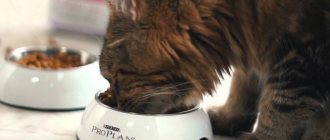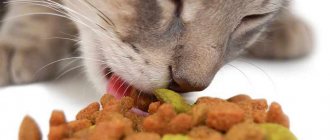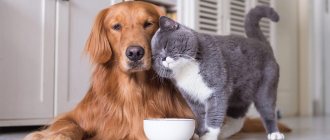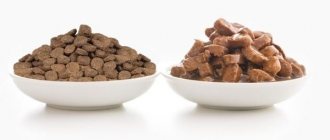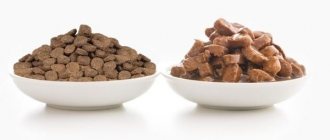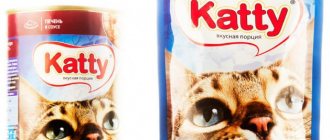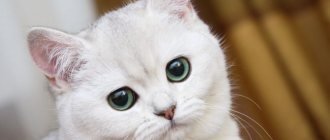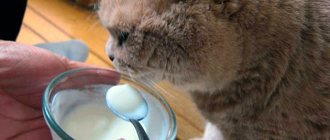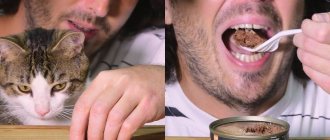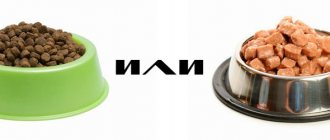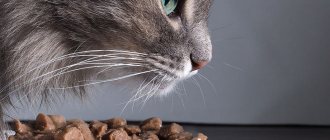7310Pavel
5
Some cat owners, especially those who are still inexperienced, choose dry food because of the apparent ease of use: the pet just needs to have a bowl into which food needs to be poured twice a day in the right quantity. All that remains is to make sure that there is fresh water in the other one - and no hassle. In fact, the question of how to properly feed a cat dry food is much more complicated.
With this feeding method, it is very important to take care of the animal’s health and follow several feeding recommendations from professionals.
© shutterstock
Rule one - don't mix
Some owners, feeling sorry for their pet, dilute its dry diet with natural food, which, in their opinion, is healthy. This is how pork cutlets, smoked meats, salted fish appear in the bowl - that is, everything that is actually contraindicated for cats. When pets develop problems with the liver and pancreas, there is a high degree of probability that the reason lies precisely in how the owners preferred to feed them.
In addition, there is another reason why you cannot give homemade food and dry food at the same time - they are digested using different enzymes. The amount of gastric juice also differs. Therefore, mixing these types of nutrition puts a double burden on both the stomach and the liver.
A separate topic concerns mixing dry and wet nutrition. There is no consensus on this matter, but in principle it is possible to periodically give canned food (best from one manufacturer). It is important to ensure that they make up no more than a quarter of the daily diet. The problem with wet food is that cats love it much more, which is why they tend to overeat - and this is a direct path to dangerous obesity.
What nutrients do cats need and why?
Protein
Cats have almost 3 times more need for protein than dogs; they really can’t live without it. In addition to the fact that mustachioed pets have an exceptional need for a constant supply of essential amino acids to the body, there is also a difference in protein metabolism. If there is a lack of protein in food, the liver will begin to consume it from the cat’s body, depleting it. In dogs, the speed and level of its decomposition reflexively decreases, due to which its preservation and need increase.
Such a high need is explained by the body’s constant need for essential amino acids - leucine, threonine, arginine, lysine, phenylalanine, etc. These substances are needed to maintain the normal condition of the coat, as well as for a sufficient amount of feline - a unique substance excreted in cats in the urine. There is especially a lot of it in cats - it is this that gives such a pungent smell to the urine of adult sexually mature individuals.
Another very important essential acid for Murok and Murzikov is taurine. It is synthesized in the body of dogs, but not in cats.
This amino acid is absent in protein, but is found in muscle fibers of animal origin, i.e. meat is a pure protein product. Lack of dietary intake leads to disruption of the reproductive system, cardiovascular system and destruction of the retina. There are even special taurine deficiency syndromes associated specifically with disruption of the above-mentioned organs and systems.
Protein must be supplied to cats' bodies constantly! Source of protein for cats: meat, fish, dairy products. Source of taurine: meat and fish (mostly in turkey and raw tuna).
Fats
Not only the energy value of the food depends on this nutrient, but also its palatability for animals (of course, vegetable oil for a cat will be less attractive in smell and taste). In addition to energy, fats in the body perform two more very important functions - they dissolve fat-soluble vitamins into an easily digestible state and are a source of essential fatty acids. A cat's daily diet should contain at least 15% fat, and if it is a kitten, then all 20%.
Carbohydrates
They consist of difficult-to-digest (fiber) and easily-digestible (starch and sugar). Fiber is needed for physiologically normal fecal formation. With enough of it - as much as needed - the cat will never have constipation or diarrhea due to nutrition. An excess of easily digestible carbohydrates leads to obesity and can trigger the development of diabetes.
Cats should receive 0.32 g of fiber and no more than 2.7 g of easily digestible carbohydrates per kilogram of weight per day.
Source of carbohydrates for cats: cereals (buckwheat, rice), bran, honey. The fiber comes from the same place plus vegetables.
Minerals and vitamins
Like any living organism, cats also need vitamins and minerals. The need for these substances can be met with the help of special vitamin complexes and feed additives. There are several nuances: cats do not need vitamin C, because... They produce it in the liver, but they need direct vitamin A, not beta-carotene, because the transformation of one substance into another does not occur in their body. This means that you should not feed Murka citrus fruits during a cold, and carrots in the diet should be replaced with liver.
Grinchuk Ekaterina Andreevna veterinarian
Rule two - only the best
To properly feed your cat dry food, you need to choose only the super premium category.
© shutterstock
Cheap ready-made food has a number of significant disadvantages:
- made from completely useless parts of animals and birds - hooves, feathers, bones are processed for it;
- This food contains a lot of gluten, and this is completely unacceptable, since it is one of the most powerful cat allergens.
So economy-class food poses a direct threat to the cat’s health.
Nutritional and energy needs of cats
What is the essence of feeding animals in general? To replenish the energy and nutrients needed to maintain their normal functioning. The needs for all this depend on many factors:
- body weight and constitution (the smaller the cat, the more intense its metabolism, because there is more energy loss due to the high ratio of body surface area to mass);
- gender and age (young animals need more than older animals, cats need more than cats);
- physiological condition (pregnant, lactating and sick animals have special needs);
- ambient temperature (the hotter it is, the less you want to eat).
Rule three - water must be present
Moreover, the water is clean and always fresh. Some owners, again showing dubious concern for their pet, replace it with milk. However, this should not be done with an adult cat, otherwise he will have problems with the gastrointestinal tract.
The volume of fluid is also important - if you feed your cat dry food, you need to triple the daily amount recommended by veterinarians. In this case, it is calculated depending on the amount of feed: it should be three times more.
There are cats that drink little, for whom choosing unmoistened food can even be dangerous. If you cannot give canned food for some reason, you need to pre-soak dry cat food in the appropriate proportion. It turns out to be a kind of soup: at first the animal may refuse it, but if you are persistent, it will gradually get used to it and feeding it will become easier.
In what cases is industrial food better than natural food?
There are several points when it is better to replace natural products with industrial food:
- The owner is often not at home . Natural ingredients spoil quickly, especially in hot weather. If the breeder has an automatic feeder, it is necessary to use only industrial feed. This option is suitable for those people whose work requires travel.
- A person has a spayed or neutered cat. Manufacturers have taken care of pets by creating a specialized product that contains all the necessary substances and does not contribute to excess weight gain. At home, it is important to carefully select ingredients without disrupting metabolism. The amount of carbohydrates is reduced by 30%.
- The cat is sick with something. For animals with diabetes, kidney disease or urolithiasis, special lines of food have been developed taking into account the need for vitamins and minerals. It is difficult to maintain such a diet at home.
For any illness, it is important to consult a veterinarian; he will prescribe a diet.
Rule four - give exactly as much food as required
The packaging of good food always indicates how much dry cat food should be given. Gullible owners think that the portions are calculated by experts and are exactly suitable for an animal of this weight and age. However, in fact, even the best producers are often cunning, because they are interested in running out of food faster and, accordingly, buying it again.
© shutterstock
You can and should use the sign, but with your own little trick - in your mind, reduce the cat’s weight by a kilogram and feed him the same portion of food as if he really weighed less. Such advice will help keep the animal's health in order and protect it from overeating - and, accordingly, obesity again.
For the same reason, it is better to check the volume of the food measuring cup - and these are often included with the packaging - on a kitchen scale. Sometimes owners overfeed their pets and don’t know it themselves.
Feed from different manufacturers
Having studied the packaging of ready-made food, we see that each manufacturer considers its products to be the best for kittens. It would seem that by taking the “best” from different manufacturers, you can provide your pet with all the necessary substances plus diversify its diet. However, everything is not so simple.
The product line of each brand is developed with its own characteristics in composition, combination of components and vitamin and mineral supplements. By choosing one brand for feeding, you can be sure that the components of the feed are interchangeable and complement each other.
By purchasing different foods for our pet, instead of proper nutrition, we risk getting complications from the gastrointestinal tract or, even worse, irreversible metabolic disorders.
If the kitten eats one brand, he is cheerful and playful, and does not show anxiety, do not change the food. This will protect you from problems in the future.
A few words about ready-made food. When a kitten owner prefers commercially prepared food, only brands marked Premium or Superpremium should be selected. Products in the mid-price category are not suitable - they have an unbalanced composition and often use low-quality raw materials. Special lines of ready-made food designed for 1-month-old kittens are produced by many companies with a proven reputation:
- Royal canin food labeled Mother and Babycat. The product is approved for use by kittens over one month of age. Available in granular form, quickly soluble in water. The food contains easily digestible protein, which is necessary for the normal development of the pet.
- Hill's Science Plan Kitten Mousse and Granular Mix. The manufacturer of this food focused on natural ingredients, such as turkey and poultry protein.
- Arden Grange Kitten - food with the addition of prebiotics (substances to improve food digestion). The protein level in the mixture is 34%.
- Perfect fit Junior is a ready-made mixture with conflicting reviews, despite its attractive price and high-quality composition. The food, containing 24% protein, is additionally fortified and enriched with mineral components.
- Eukanuba Cat Kitten is an industrial food made from chicken liver and chicken meat. It has a high protein level – 36%. Without preservatives or flavor enhancers.
- Pro plan junior is an industrial feed with an optimal composition. In addition to 20% chicken meat, the composition includes cow's colostrum to enhance immunity and form normal intestinal microflora. Protein levels increased to 42%.
Best articles: Economy class cat food
When choosing food for a kitten, you should focus on both the composition and the baby’s individual needs. Almost all premium-class food has a wide range of finished product flavors that can satisfy the little picky eater.
Kitten eats on its own
Rule five - do not change the food (if possible)
Cats are not people; they do not get bored with a monotonous diet; moreover, feeding them canned and dry food is useful for them, since the cat’s delicate stomach gets used to food, and the animal gets sick much less often.
If for some reason you still need to change the food, then the change must be made gradually and after consultation with a veterinarian, who will suggest the correct regimen.
In general, a two-week transition scheme is used, which looks like this: at the first feeding, 20% of the new food is added, then with each feeding (and you need to feed twice a day), a little more is added until the old one is completely replaced. This is also useful for the reason that in the process you can observe how the cat’s body reacts to such changes. It may be worth choosing something else - this need is indicated by diarrhea, constipation, and other atypical reactions to food.
© shutterstock
It is very important not to change it during some stressful period of life for the cat - otherwise he will associate such a change with unpleasant sensations and will have a negative attitude towards the new food.
How, how much and when?
If the kitten has never tried dry food before, the granules for it need to be soaked and given a new portion each time so that the food does not dry out or spoil. As soon as he gets used to the innovations, you can gradually add dry granules to the soaked food and further increase their share until it reaches 100%.
As long as you soak the food, the daily amount will have to be divided by the number of feedings and given out by the hour. The younger the kitten, the more often it needs to be fed.
| Kitten age, months. | Number of feedings per day |
| 1–2 | 4–5 |
| 3–4 | 4 |
| 5–6 | 3 |
If you give food in dry form, it is permissible to leave it freely available - consuming food in small portions throughout the day corresponds to the physiological needs of cats: in nature, they eat often and little by little, and not only during the daytime.
However, the daily norm should not be exceeded. And don’t be confused by the fact that this is extremely small, because a kitten’s stomach is not big either. Representatives of the cat family for the most part are not prone to gluttony, but exceptions still occur, especially for animals that are found on the street and have been starving for a long time.
Feeding a kitten natural food
Natural food for kittens is similar in composition to what is given to adults, but with some reservations. First, let's answer a few questions about meat.
First: when can a kitten be given meat? Starting from one month of age (3-4 weeks), babies are given complementary foods in the form of raw minced meat or finely chopped pieces. A good option would be chicken or turkey meat. We give the kittens the same food that their mother eats. Yes, they themselves will begin to “shop” in her bowl when the time comes. Complementary feeding begins with one type of meat, the rest are introduced gradually.
Question two: can kittens eat raw meat? Raw meat is not only possible for kittens, but also necessary. It is raw frozen meat that helps set the digestive system in the right way.
But fermented milk products and vegetables are introduced later - only when the kittens are already good at digesting different types of meat. We introduce fish into the diet when the kittens are several months old.
Read more about how to feed a kitten natural food month by month in a separate article. The article was written in relation to the Scottish breed, but this feeding system is suitable for all domestic cats.
https://youtube.com/watch?v=yMvd7rmwv2M
Natural food recipes
There are two options for feeding natural food: monofeeding and mixes. Monofeeding involves eating one or two types of meat, usually in noticeably large pieces. Mixes are mixtures of different types of meat and offal with other ingredients. Before serving, the meat is frozen in the freezer for at least 3 days in portioned bags. Before serving, defrost and warm naturally to room temperature. If you need to heat it up quickly, you can put the bag in water at room temperature.
A scheme that you need to follow to plan the diet and ensure that the cat is always fed.
- We plan the menu a week or two in advance, if freezer space allows. We calculate how much a cat should eat per day, multiply by the number of days for which it should be enough. From this number of kilograms we calculate how much muscle meat and hearts should be, how many organs, how many meat bones and how many vegetables. Convert percentages to grams (kilograms). Based on this, we write a shopping list. It is not necessary to calculate down to the gram; an approximate proportion is sufficient. For example, a cat weighs 5 kg, 5% per day of his body weight = 250 g. To create a menu for a week, you need to multiply 250 g by 7 days, we get 1750 g. Of this, a third (about 580 g) are meat bones, half (875 g) is muscle meat, the rest (about 300 g) is organs or organs with a pinch of grated vegetables. Based on this, you need to buy, for example, 580 g of chicken necks, 875 g of hearts or thighs and 300 g of stomachs at the market or supermarket. It is enough to calculate the proportion once and follow it. If the animal is growing, then we weigh it every week and adjust the numbers.
- We go to trusted retail outlets or order the required amount of products on the Internet. We stock up on small bags or containers for laying out the meat.
- If we make mixes, then we throw in muscle meat, meat bones and organs, and vegetables. All this can be pre-ground in a meat grinder or cut into small pieces, or you can leave it in the form of large pieces if the cat can chew them. When monofeeding, we do the same thing, only we put one or two types of meat in each bag. We weigh each bag on a kitchen scale. One packet can equal one serving or a daily serving for two meals.
- We put the bags in the refrigerator. It is advisable to write on them the start date of freezing or mark it somewhere so as not to forget.
- When the right time comes, take out the bag and defrost the meat. Serve your cat food at room temperature.
- When there are 3-5 bags left in the freezer, we do everything again: buy, chop, freeze.
To make it easier to create a menu, here are recipes for natural food for cats. Each owner can make his own using the correct proportions. But there are also ready-made ones from specialists.
Assorted
Turkey legs - 1 kg, heart (pork, beef, chicken, turkey) - 1 kg, turkey liver, beaten and cut chicken necks - 1 neck per bowl, grated seasonal vegetables (for example, carrots or pumpkin) - pinch, dried kelp (added just before serving).
Chicken mix
Chicken thigh meat - 25%, chicken breast meat - 25%, chicken backs and necks twisted in a meat grinder - 25%, chicken heads twisted in a meat grinder - 5%, chicken liver - 5%, chicken hearts and gizzards - 10%, cauliflower - 1%, grated pumpkin - 1%, grated cucumber - 1%, grated apple - 1%, kelp (dried seaweed) - 0.3%, piece of trout - 1%.
Turkey mix
Turkey thigh meat - 25%, turkey breast meat - 25%, turkey necks - 30%, turkey heart - 5%, turkey gizzards - 10%, cauliflower - 1%, pumpkin - 1%, zucchini - 1%, apple - 1%, lingonberry - 0.5%, kelp - 0.3%, trout oil - 0.2%.
Healthy cats should not be served meat in the form of soups, broths, minced meat or pate. The cat should eat pieces - small, medium or large. Large ones are preferable if the cat can handle them.
EXPERT COMMENT: VETERINARIAN-FELINOLOGIST YULIA BROVKO
How often does a cat eat
If we talk about how many times a cat should be fed per day, then there are no special differences from feeding a cat. The only thing that should be noted is that cats, especially growing ones, have less control over their appetite, and therefore more often than females have problems with weight. There are many people who like to eat often; it is necessary to initially strictly limit the amount of food given out.
Contrary to popular belief that the nutrition of a castrated cat should differ significantly from the diet of an uncastrated cat, both brothers can be fed the same. Those who say the opposite believe that the body of a castrato is more susceptible to the development of urolithiasis. In fact, the concentration of urine increases when cats drink little and eat dry commercial food.
Natural products
Super-premium food is more expensive than meat, and there is no guarantee that you will buy high-quality pellets. To be calm about your cat’s health, you need to choose a natural type of feeding and take the time to study suitable products.
The basis of the diet is meat protein (at least 50%, preferably 75%). It is found in the following products:
- Beef;
- Veal;
- Turkey;
- Chicken;
- By-products (liver, kidneys, ventricles, lungs);
- Rabbit.
It is better to give the meat raw in small pieces, after freezing it first. Boil the offal. Pork is not suitable as it is too fatty. Meat is given to the pet every day.
You need to be careful with fish. If you offer your cat such a product, then no more than once every 2 weeks, only sea food, boiled, without bones. Frequent consumption of fish leads to urolithiasis, and river species are infested with worms.
Boiled offal and meat are mixed with cereals. Raw meat is given as a separate meal. Suitable cereals include rice, buckwheat, and oats. Corn, wheat and barley are difficult for your pet's stomach to digest because they contain gluten. Cereals are offered to your pet 2-3 times a week.
Additionally, the cat is given the following products:
- Quail eggs (1 time per week);
- Cottage cheese (2-3 times a week);
- Fermented milk drinks (kefir, sour cream, natural yogurt, cream). If there are no digestive disorders, they can be offered every day;
- Vegetables: carrots, zucchini, beets, cabbage, cucumbers, broccoli (every day);
- Sprouted oat grass (every day).
When feeding naturally, vitamin and mineral complexes for cats are included in the diet. The exact dosage and frequency of administration is determined by the veterinarian.
How many times a day should I feed my cat natural foods?
A healthy adult pet will need 2-3 meals. Kittens are fed more often, in small portions.
The daily weight of food consumed for an adult cat is 5% of its weight. At the same time, at least 50% should be meat and offal. They are supplemented with either cereals and vegetables, or dairy products. More detailed indicators in grams are given in the table below. For kittens, the daily portion is distributed into 4-6 doses depending on age.
Daily intake of natural products for cats, grams
| Adult cat weight (kg) | Meat and offal (daily) | Cereals (2-3 times a week) | Vegetables (daily) | Fermented milk drinks (daily, if there are no problems with the gastrointestinal tract) |
| 3 | 80 | 45 | 10-15 | 70 |
| 4 | 100 | 60 | 20-30 | 80 |
| 5 | 125 | 75 | 25-35 | 100 |
| 6 | 150 | 90 | 30-40 | 130 |
How much dry food should a cat eat per day?
The volume of dry cat food depends on a number of factors. When determining it, the following are taken into account:
- weight;
- age;
- breed;
- pet's health status.
Please note that this list does not include the phrases “cat’s taste preferences” and “pet’s request to feed.”
In order to calculate how much dry food to give your cat, you first need to weigh it. This can be done at home using bathroom scales. To do this, pick up your pet and step on the scale. Then repeat the same thing, but without the animal. The difference between the numbers obtained is the weight of the cat.
The required weight of feed per day is calculated using the calorie content of the feed, which the manufacturer indicates on the packaging. An adult healthy domestic cat needs approximately 60 kcal per kilogram of body weight per day. Premium class food has an average calorie content of 140-200 kcal/100g. Let's assume that the cat weighs 3 kg. She is healthy and her age does not exceed 5-6 years. He eats food with a calorie content of 150 kcal/100g. In this case, she needs about 40 g of dry food per 1 kg of weight per day. That is, a cat with a body weight of 3 kg needs 120 g of dry food daily. However, this figure may be different. It all depends on the food itself, because the composition varies. The label always indicates the calorie content and the daily volume of food that should be given to the animal per 1 kg of weight.
An older pet with the same body weight is given less: about 30 g of dry food. But a kitten is entitled to more. If you examine food packages, you will find out that no matter what product you choose, the volume of food for a cat will be at least 1.5 times greater than the needs of an adult animal.
For example, on the packaging of Acana Wild Prairie food it is indicated that an adult pet needs 35 g of food, an elderly pet needs 30 g, and a kitten needs 60 g per 1 kg of weight per day.
For pregnant and lactating animals, approximately 25% is added to the diet. If you are overweight, the portions are reduced.
The main thing when feeding dry food is to focus not on the number of meals, but on its daily volume. One animal can eat 75-85 g 2 times a day, and another 5-6 times, but in half smaller portions.
